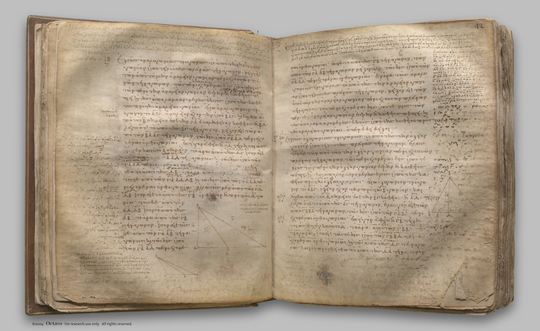index prev next | digilib folio 46

In obtuse-angled triangles the square on the side subtending the obtuse angle is greater than the squares on the sides containing the obtuse angle by twice the rectangle contained by one of the sides about the obtuse angle, namely that on which the perpendicular falls, and the straight line cut off outside by the perpendicular towards the obtuse angle.
| Ἐν τοῖς ἀμβλυγωνίοις τριγώνοις τὸ ἀπὸ τῆς τὴν ἀμβλεῖαν γωνίαν ὑποτεινούσης πλευρᾶς τετράγωνον μεῖζόν ἐστι τῶν ἀπὸ τῶν τὴν ἀμβλεῖαν γωνίαν περιεχουσῶν πλευρῶν τετραγώνων τῷ περιεχομένῳ δὶς ὑπό τε μιᾶς τῶν περὶ τὴν ἀμβλεῖαν γωνίαν, ἐφ' ἣν ἡ κάθετος πίπτει, καὶ τῆς ἀπολαμβανομένης ἐκτὸς ὑπὸ τῆς καθέτου πρὸς τῇ ἀμβλείᾳ γωνίᾳ. Ἔστω ἀμβλυγώνιον τρίγωνον τὸ ΑΒΓ ἀμβλεῖαν ἔχον τὴν ὑπὸ ΒΑΓ, καὶ ἤχθω ἀπὸ τοῦ Β σημείου ἐπὶ τὴν ΓΑ ἐκβληθεῖσαν κάθετος ἡ ΒΔ. λέγω, ὅτι τὸ ἀπὸ τῆς ΒΓ τετράγωνον μεῖζόν ἐστι τῶν ἀπὸ τῶν ΒΑ, ΑΓ τετραγώνων τῷ δὶς ὑπὸ τῶν ΓΑ, ΑΔ περιεχομένῳ ὀρθογωνίῳ. Ἐπεὶ γὰρ εὐθεῖα ἡ ΓΑ τέτμηται, ὡς ἔτυχεν, κατὰ τὸ Α σημεῖον, τὸ ἄρα ἀπὸ τῆς ΔΓ ἴσον ἐστὶ τοῖς ἀπὸ τῶν ΓΑ, ΑΔ τετραγώνοις καὶ τῷ δὶς ὑπὸ τῶν ΓΑ, ΑΔ περιεχομένῳ ὀρθογωνίῳ. κοινὸν προσκείσθω τὸ ἀπὸ τῆς ΔΒ: τὰ ἄρα ἀπὸ τῶν ΓΔ, ΔΒ ἴσα ἐστὶ τοῖς τε ἀπὸ τῶν ΓΑ, ΑΔ, ΔΒ τετραγώνοις καὶ τῷ δὶς ὑπὸ τῶν ΓΑ, ΑΔ [ περιεχομένῳ ὀρθογωνίῳ ]. ἀλλὰ τοῖς μὲν ἀπὸ τῶν ΓΔ, ΔΒ ἴσον ἐστὶ τὸ ἀπὸ τῆς ΓΒ: ὀρθὴ γὰρ ἡ πρὸς τῷ Δ γωνία: τοῖς δὲ ἀπὸ τῶν ΑΔ, ΔΒ ἴσον τὸ ἀπὸ τῆς ΑΒ: τὸ ἄρα ἀπὸ τῆς ΓΒ τετράγωνον ἴσον ἐστὶ τοῖς τε ἀπὸ τῶν ΓΑ, ΑΒ τετραγώνοις καὶ τῷ δὶς ὑπὸ τῶν ΓΑ, ΑΔ περιεχομένῳ ὀρθογωνίῳ: ὥστε τὸ ἀπὸ τῆς ΓΒ τετράγωνον τῶν ἀπὸ τῶν ΓΑ, ΑΒ τετραγώνων μεῖζόν ἐστι τῷ δὶς ὑπὸ τῶν ΓΑ, ΑΔ περιεχομένῳ ὀρθογωνίῳ. Ἐν ἄρα τοῖς ἀμβλυγωνίοις τριγώνοις τὸ ἀπὸ τῆς τὴν ἀμβλεῖαν γωνίαν ὑποτεινούσης πλευρᾶς τετράγωνον μεῖζόν ἐστι τῶν ἀπὸ τῶν τὴν ἀμβλεῖαν γωνίαν περιεχουσῶν πλευρῶν τετραγώνων τῷ περιεχομένῳ δὶς ὑπό τε μιᾶς τῶν περὶ τὴν ἀμβλεῖαν γωνίαν, ἐφ' ἣν ἡ κάθετος πίπτει, καὶ τῆς ἀπολαμβανομένης ἐκτὸς ὑπὸ τῆς καθέτου πρὸς τῇ ἀμβλείᾳ γωνίᾳ: ὅπερ ἔδει δεῖξαι. | In obtuse-angled triangles the square on the side subtending the obtuse angle is greater than the squares on the sides containing the obtuse angle by twice the rectangle contained by one of the sides about the obtuse angle, namely that on which the perpendicular falls, and the straight line cut off outside by the perpendicular towards the obtuse angle. Let ABC be an obtuse-angled triangle having the angle BAC obtuse, and let BD be drawn from the point B perpendicular to CA produced; I say that the square on BC is greater than the squares on BA, AC by twice the rectangle contained by CA, AD. For, since the straight line CD has been cut at random at the point A, the square on DC is equal to the squares on CA, AD and twice the rectangle contained by CA, AD. [II. 4] Let the square on DB be added to each; therefore the squares on CD, DB are equal to the squares on CA, AD, DB and twice the rectangle CA, AD. But the square on CB is equal to the squares on CD, DB, for the angle at D is right; [I. 47] and the square on AB is equal to the squares on AD, DB; [I. 47] therefore the square on CB is equal to the squares on CA, AB and twice the rectangle contained by CA, AD; so that the square on CB is greater than the squares on CA, AB by twice the rectangle contained by CA, AD. |